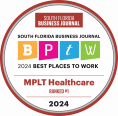
It's no secret that healthcare is far from predictable. Patient needs tend to rise and fall depending on the time of year, and many healthcare facilities experience seasonal trends, whether it’s flu season, an increase in summer injuries, or end-of-year elective procedures. While these patterns may be familiar, staffing appropriately for them is what remains a challenge. Fortunately, locum tenens support offer a flexible and strategic solution. Read on for key ways your facility can use locum tenens to manage seasonal surges without compromising patient care.
Understanding Spikes in Patient Volume
From urgent care centers to community hospitals, every healthcare facility experiences some form of seasonal patient influx. For example:
- Winter months can often bring respiratory infections, flu complications, and increased hospitalizations for chronic conditions.
- Summer can lead to more emergency room visits due to travel-related accidents, heat exposure, or sports injuries.
- The end of the year can frequently see a rise in elective surgeries as patients rush to use their insurance benefits before they reset.
- College towns may see spikes aligned with the academic calendar, while tourist-heavy areas face predictable surges during holiday seasons.
Even when many of these spikes are expected, they can still overwhelm clinical teams and affect patient flow without a solid staffing plan in place.
The Impact on Permanent Staff
One of the biggest risks healthcare facilities may face during these volume surges is navigating provider burnout. When patient loads increase and staffing doesn’t keep up, physicians, nurse practitioners, and other patient care team members are stretched thin. Over time, this can contribute to fatigue, emotional exhaustion, and even higher turnover rates.
By leveraging locum tenens for patient volume spikes, facilities can give their core staff the support they need. Locums providers can help absorb the additional workload, maintain safe provider-to-patient ratios, and allow full-time staff to focus on delivering high-quality care while also preventing burning out.
Flexible Staffing Without Long-Term Commitment
Not every surge justifies hiring new full-time employees. In many instances, short-term needs don’t align with the overhead that comes with permanent staffing. Locum tenens providers can help to fill that gap, offering short-term support without the long-term cost.
Whether your facility needs coverage for a few shifts, a multi-week stretch, or an entire season, locum tenens professionals are adaptable and ready to contribute. They’re often experienced across different care settings and are trained to integrate quickly, making them ideal for high-demand times. This flexible approach helps facilities stay agile, meet rising demand, and avoid unnecessary payroll expenses.
Supporting Continuous Care During High-Demand Periods
There’s a common misconception that temporary providers might disrupt continuity of care. However, in reality, when placed correctly and onboarded effectively, locums tenens providers can maintain and even enhance the patient experience.
Many facilities even choose to bring back the same providers each year during peak seasons. These returning clinicians already know the systems, the staff, and the expectations. Their familiarity contributes to smoother workflows, faster onboarding, and a consistent level of care. Continuity isn’t about job titles, it’s about performance, reliability, and patient outcomes. And with the right locum support, that consistency remains strong, even in your busiest times.
Avoiding Disruptions During Staff Vacations or Leave
Seasonal surges often overlap with provider vacations, holidays, or scheduled leave. While time off is essential for long-term retention and mental health, it can also create temporary gaps in coverage. Locum tenens staffing allows your full-time staff to take time off without added stress about who will fill in.
Rather than asking that internal staff pick up extra shifts or stretch their limits, locums providers step in to keep schedules running smoothly and care uninterrupted.
Staying Compliant and Credentialed
During busy periods, compliance and credentialing can’t fall by the wayside. Partnering with an experienced locum tenens agency, like MPLT Healthcare, ensures every provider is fully licensed, credentialed, and ready to practice in your facility and state.
Agencies take on the administrative burden of verifying credentials, tracking licensing, and staying current with state and federal requirements. This helps maintain compliance and ensures your staff can focus on patient care, rather than paperwork.
Cost-Effective Coverage for Temporary Needs
Locum tenens staffing is not only flexible, it’s often more cost-effective than hiring permanent providers for short-term surges. There are no long-term benefit costs or onboarding expenses, and facilities can scale staffing up or down based on actual demand.
By planning in advance for expected spikes, healthcare organizations can use their budget more efficiently, allocate resources where needed most, and avoid paying overtime or burnout-related turnover costs.
Building a Staffing Strategy in Advance
To make the most of locum tenens coverage during busy seasons, it’s important to properly think ahead. A proactive plan allows your team to be fully prepared when demand starts to rise.
In many cases, it’s also helpful to request repeat providers from previous assignments for added continuity and reduced training time. These familiar faces can step in seamlessly and support your team with minimal disruption.
Locum tenens for patient volume spikes is more than just a backup plan, it’s a smart, strategic solution that allows healthcare facilities to remain resilient, responsive, and patient-focused. By incorporating locum staffing into your seasonal planning, your organization can meet demand head-on, without sacrificing care quality or staff well-being.
Ready to Strengthen Your Surge Staffing Plan?
Contact our team today to learn how locum tenens support can help your facility manage seasonal volume increases while maintaining excellent patient care.








